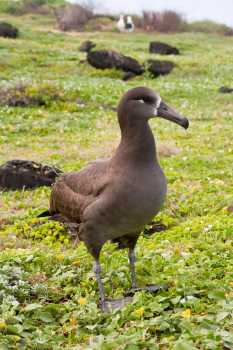BirdLife International manages a Globally Threatened Forum for Seabirds which considers which threatened species should be recategorized.
Discussions on the status of ACAP-listed Northern Royal Albatross Diomedea sanfordi (click here) and Black-footed Albatross Phoebastria nigripes were undertaken by the Forum in 2011, but both species have had their reassessments pended as there was insufficient information available by this year's deadline. Discussions remain open for input and these species will now be assessed as part of the next comprehensive re-evaluation of all species, due for release in May 2012.
The Black-footed Albatross Phoebastria nigripes is currently listed as Endangered on the basis that its population is projected to decline by more than 60% over 56 years (estimate of three generations), as modelled using a moderate scenario for fisheries bycatch of 8000 birds a year. It has been suggested, however, that the demographic parameters for this model, namely survival probability, growth probability and fecundity, were based on data from the 1960s and 1970s, for which it was incorrectly assumed that no bycatch took place. This implies that the basic parameters for a stable population with no additional mortality were actually estimated from a population already experiencing significant bycatch, and were thus underestimated. This appears to have led to an overestimation of the declines that would result from annual bycatch scenarios, by counting this source of mortality both within the demographic parameter estimates and within the simulation scenario, effectively doubling the impact of fisheries.
Nevertheless, likely bycatch levels are still predicted to cause a decline in the population, albeit not as rapid as previously forecast. Other studies on this species have confirmed the impact of fisheries bycatch on survival and the annual population growth rate. Annual bycatch was estimated at 5228 birds in 2005, which, if doubled to account for underestimation, approaches the maximum Potential Biological Removal (PBR) level of 11 980 birds, which is calculated to be the maximum level of off-take possible without causing a decline. The maximum PBR level for this species has also been estimated at 8850 birds per year and 10 000 birds per year. It still remains necessary, however, to model robustly the future impact of bycatch on this species.
There is also uncertainty over the historic population trends of this species. Monitoring data from three colonies in Hawaii, representing over 75% of the world's population, suggested that numbers may have decreased by 9.6% from 1992 to 2001. However, linear regression analysis of log-transformed counts at the same colonies suggests that the species' population has remained stable since at least 1957 and has increased overall since 1923. Confusingly, an earlier variation on the same analysis found a decline between 1992 and 2005, highlighting the importance of considering time scales when analysing this species' population trend. Matrix modelling suggests that its population is currently stable or increasing slightly.
The recent analysis brings into question the validity of the species' current Red List status. It suggests that the rate of projected decline should be lowered, which could result in the species becoming eligible for down-listing. Comments are requested regarding the various studies on this species and the implications for its historic and future population trends.
This discussion was first published in November 2010 as part of the 2010-11 Red List update, but remains open for comment to enable reassessment in 2012.
Selected references:
Arata, J.A., Sievert, P.R. & Naughton, M.B. 2009. Status Assessment of Laysan and Black-footed Albatrosses, North Pacific Ocean, 1923-2000. U.S. Geological Survey Scientific Investigations Report 2009-5131. Reston: U.S. Geological Survey.
Cousins, K. & Cooper, J. 2000. The Population Biology of the Black-footed Albatross in Relation to Mortality caused by Longline Fishing. Honolulu: Western Pacific Regional Fishery Management Council.
Gilman, E. & Freifeld, H. 2003. Seabird mortality in North Pacific longline fisheries. Endangered Species Update 20: 35-46.
Lewison, R.L. & Crowder, L.B. 2003. Estimating fishery bycatch and effects on a vulnerable seabird population. Ecological Applications 13: 743-753.
Naughton, M.B., Romano, M.D. & Zimmerman, T.S. 2007. A Conservation Action Plan for Black-footed Albatross (Phoebastria nigripes) and Laysan Albatross (P. immutabilis). Version 1.0.
Niel, C. & Lebreton, J.-D. 2005. Using demographic invariants to detect overharvested bird populations from incomplete data. Conservation Biology 19: 826-835.
Verán, S., Gimenez, O., Flint, E., Kendall, W.L., Doherty Jr, P.F. & Lebreton, J.-D. 2007. Quantifying the impact of longline fisheries on adult survival in the Back-footed Albatross. Journal of Applied Ecology 44: 942-953.
Information taken from the Globally Threatened Forum for Seabirds with thanks.
John Cooper, ACAP Information Officer, 31 July 2011

 Español
Español  English
English  Français
Français 